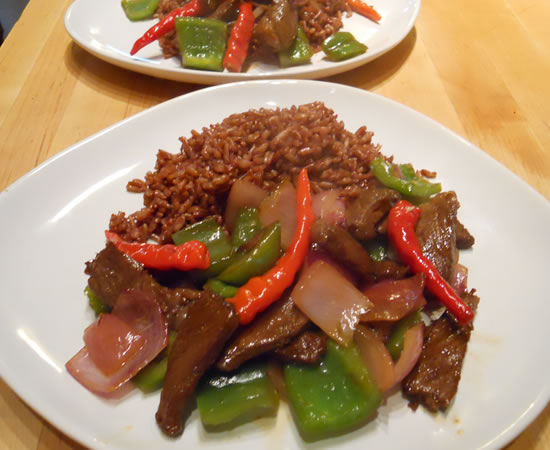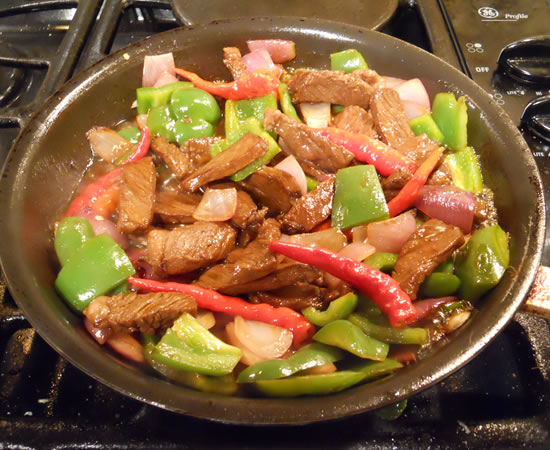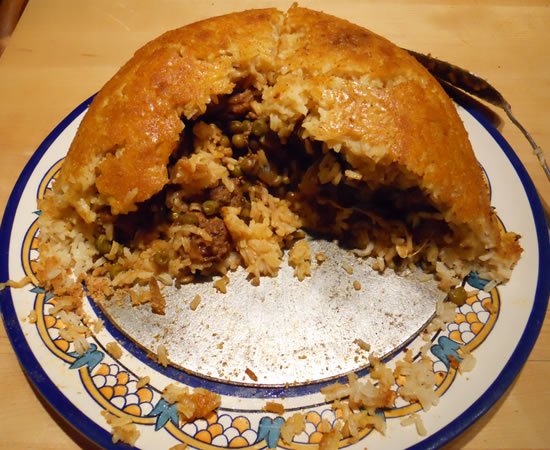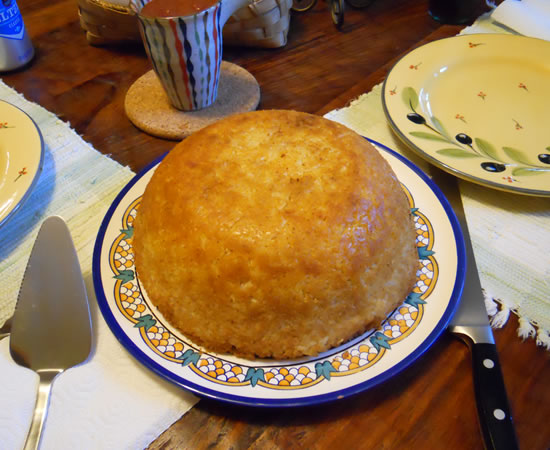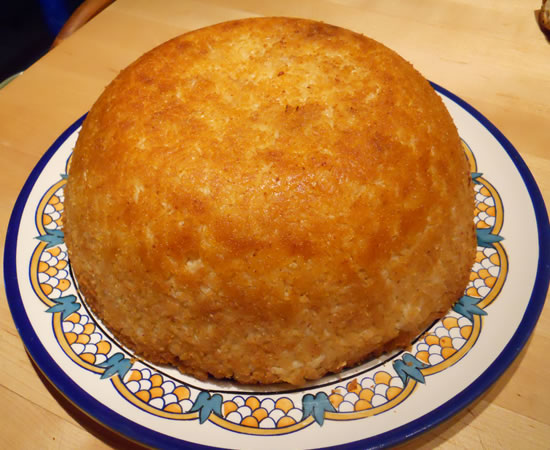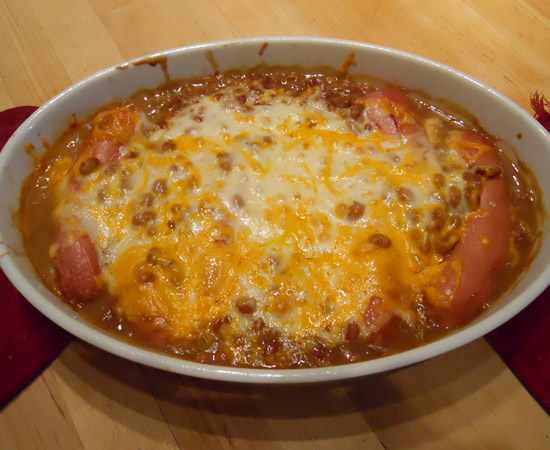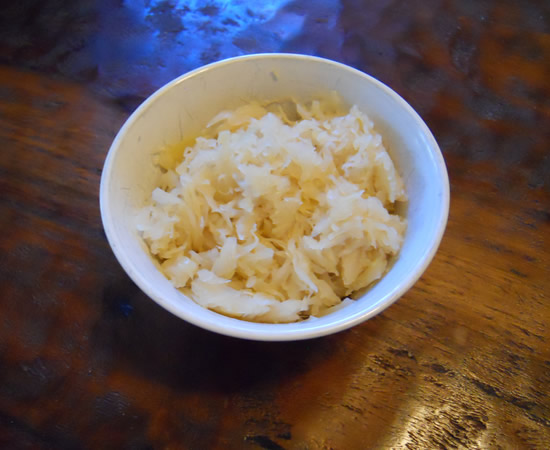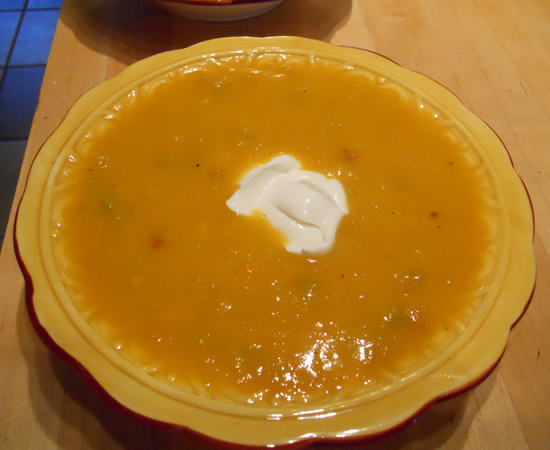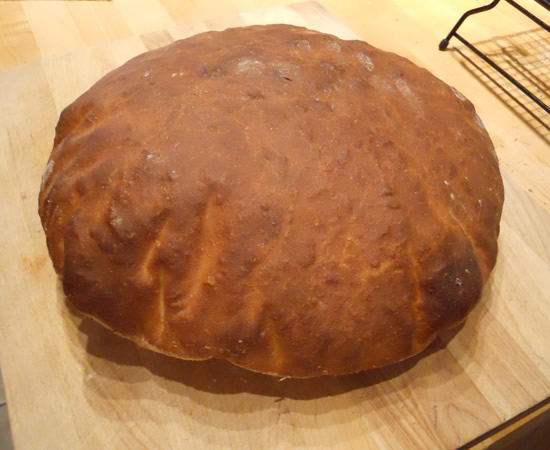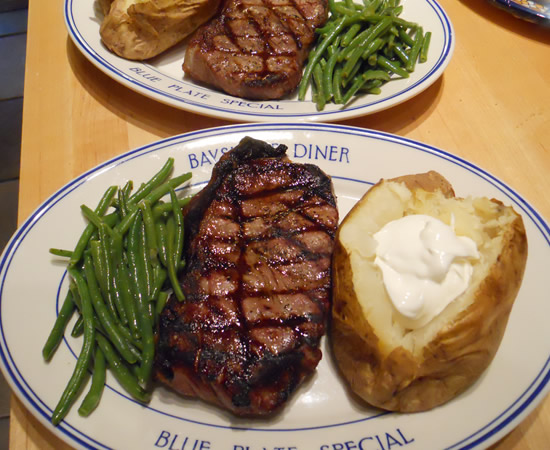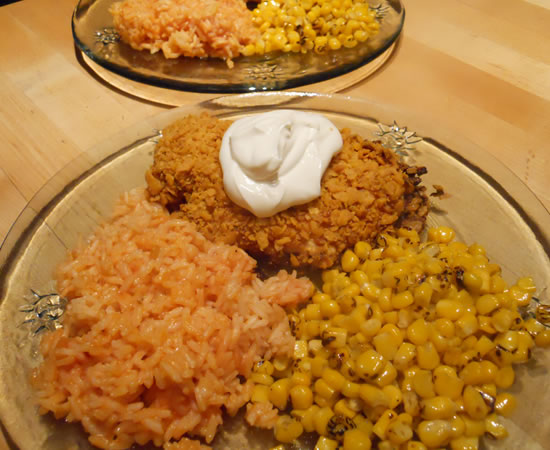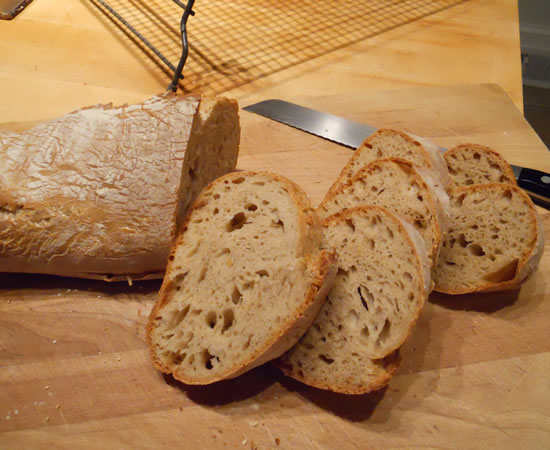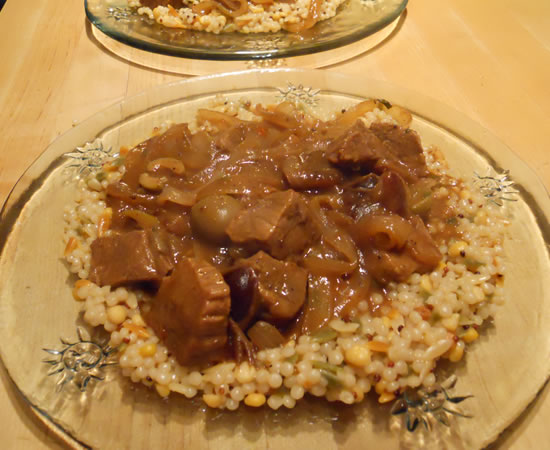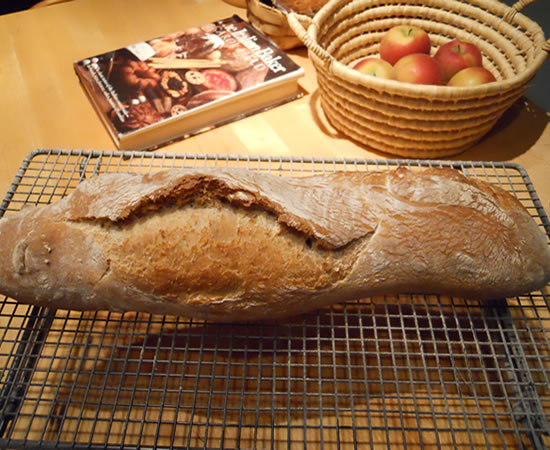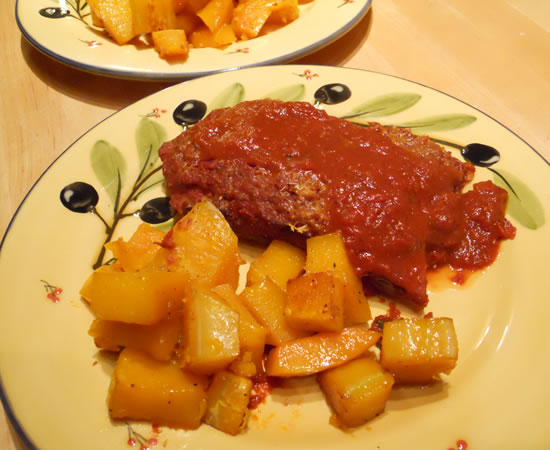Beef and Peppers
The poor stove. It takes such a beating day-in-and-day-out. As do the ovens. We just cleaned the ovens and already there's a spill causing billowing clouds of smoke in the kitchen.
We are just destined to never having a pristine kitchen.
Oh well.
We eat well - and that's really all that matters.
And speaking of eating well... the backyard pepper plants are still producing peppers. It's amazing.
And they're really good, too! The bell peppers are sweet, crisp, and full of flavor. Unfortunately, while they have nice flavor, the red peppers have absolutely no heat, at all. None. Zero. Zip.
I'm thinking they just needed more heat, less water, and less humidity to really develop, but flavor-wise, they're okay.
With still more peppers growing, a pepper steak stir-fry seemed to be in order.
I marinated strips from a couple of sirloin steaks in 2 tbsp sriracha sauce (Thai hot sauce), 2 tbsp soy sauce, 2 tbsp balsamic vinegar, 2 tbsp rice wine, and 1 tsp ground ginger. Into the hot skillet they went with a bit of sesame oil. Onions and peppers followed. I drizzled in a bit of the marinade, brought it all to a boil, and served over the red rice.
I really, really like the whole grain red rice I get from Lundberg. Actually, I get several of their rices and blends. Since our local stores stopped carrying it, I now buy it online. Helping to keep the United States Postal Service in operation, one package at a time!
It had just enough heat to be interesting, and the rice added a great textural balance.
And there's even more peppers to come!
Food For Thought

We had leftovers for dinner tonight.
I wasn't cooking - we went into Philadelphia today to lend our support for Occupy Philly.
I have to admit that food-wise, our leftovers are generally pretty good. They're definitely better than the leftovers we're getting from our current government.
Government-Bashing on a food blog?!? Well... Yes.
We have a Congress right now that wants to dismantle the government. That wants to dismantle every safety-net and social safeguard there is and that wants to allow our food to be poisoned, our air to be poisoned, and our water to be poisoned in the name of de-regulated corporate profit.
I'm not being hyperbolic about this - The EPA is under attack, USDA regulations are under attack. Food conglomerates and chemical manufacturers are fighting labeling regulations - they don't want you to know what's in your milk, tomato, chicken, ground beef, or breakfast cereal. The wealthiest of the wealthy are buying Senators and Representatives who, in turn, are doing their bidding.
Ever wonder about that label on milk or cheese that reads "No significant difference has been shown between milk derived from rbST-treated and non-rbST-treated cows.''?!? It was written by Michael R. Taylor, in 1994 who, as FDA Deputy Commissioner, shaped the agency’s policy on rBGH. Until the summer of 1991, he represented Monsanto and the International Food Biotechnology Council. Most recently he has been working as an FDA Deputy Commissioner For Foods. They continually fight efforts to allow companies to simply state that they DON'T treat their cows with rBGH. Just as with genetically modified foods or irradiated foods - they don't want us to know. They don't want us to be able to make a choice. They are passing laws to make it illegal to state that food is NOT tainted with chemicals.
There are listeria outbreaks, e coli outbreaks, salmonella outbreaks. Food-borne illnesses are rampant, but the cry is that our government is too big - too "Big Brother" trying to tell us what we can or can't eat. HELLO?!? If we want a clean food supply, we need MORE regulation, not less.
And the goal has been to keep us all too busy trying to keep a roof over our heads and make ends meet to pay attention.
And it has been succeeding.
Until now.

We bailed out Wall Street and not a single person went to jail for their illegal activities. They crippled our economy, our piddly retirement accounts went straight to hell, and they're making obscene bonuses and paying less in taxes than Victor and I did last year.
Teachers are under attack, civil servants are under attack. Unions are under attack.
My favorite quote is:
Do you Remember when teachers, public employees, Planned Parenthood, NPR and PBS crashed the stock market, wiped out half of our 401Ks, took trillions in TARP money, gave themselves billions in bonuses, and paid no taxes?
Yeah.. Me Neither.
And gays in the military?!? Guess what?!? I'm a Viet Nam Veteran. I was a Gay In The Military. And I'm married to a man. I can't begin to describe the hoops we have to jump through when April 15th rolls around, the legal crap we have to deal with after being together for 17 years.
Fed up?!? You bet I am.
And that is why I am supporting Occupy Wall Street, Occupy Philly, Occupy Wichita, Occupy Tulsa, Occupy Portland, Occupy San Francisco, and every other group out there.
We are "We, The People."
We Are The 99%.
It is past time for us to start paying attention.
Start reading labels. Stop buying crap food. Start asking questions. Start demanding answers.
Start Paying Attention.
We Are The 99%.
Sartù - Neopolitan Rice Timbale
I have died and gone to Gastronomic Heaven.
Seriously.
When I spoke with Victor at lunch today, he said he had dinner covered. Nothing else. No details. I didn't question it - that usually means something fun is going to be created.
And was I ever right!
The November issue of La Cucina Italiana magazine arrived a few days ago and as I was glancing through, one recipe in particular caught my eye - a Neopolitan Rice Timbale. I have made individual timbales many times, but the size and scope of this one intrigued me. I showed it to Victor and then filed the idea away.
Today, Victor pulled out the magazine and went to work!
Sartù - Neopolitan Rice Timbale
- 1 ounce dried wild mushrooms
- 5 tablespoons extra-virgin olive oil
- 1 small onion, thinly sliced
- 2 tablespoons tomato paste concentrate (from tube)
- 7 cups chicken or beef broth, heated to a simmer
- 1 cup frozen peas
- Salt
- Freshly ground black pepper
- 1/3 pound pork sausage
- 2/3 pound ground beef
- 1 large egg
- 5 tablespoons freshly grated Parmigiano-Reggiano cheese
- 5 tablespoons fine plain breadcrumbs, plus more for mold
- 3 tablespoons unbleached all-purpose flour
- 6 tablespoons unsalted butter, plus more for mold
- 4 ounces chicken livers, cut into small pieces
- 2 1/2 cups Arborio rice
- 4 ounces fresh mozzarella cheese, cut into cubes
Special equipment: a 2-quart mold or ovenproof bowl
Instructions
Soak dried mushrooms in 2 cups hot water for 20 minutes; drain, reserving liquid, and finely chop.
Heat oven to 350°.
In a large saucepan, heat 2 tablespoons oil over medium-high heat. Add onion and cook, stirring occasionally, until softened, about 5 minutes. Dilute tomato paste in 1 cup broth, then add to pan with onion. Add mushrooms, peas and pinch salt and pepper; bring to a simmer. Add sausage and simmer, covered, until sausage is nearly cooked through, about 10 minutes. Transfer sausage to a cutting board and slice in to 1/4-inch pieces. Return pieces to skillet and simmer, uncovered, until liquid is mostly evaporated, about 10 minutes more. Remove from heat.
In a bowl, stir together beef, egg, 1 tablespoon Parmigiano-Reggiano, 1 tablespoon breadcrumbs, 1/4 teaspoon salt and 1/4 teaspoon pepper. Form into 1 1/2-inch balls.
In a large skillet, heat remaining 3 tablespoons oil over medium-high heat until hot but not smoking. Dust meatballs lightly with flour and fry in 2 batches until golden on all sides, about 5 minutes. Drain on paper towels. Drain oil from skillet and wipe clean with paper towels. Melt 1 tablespoon butter in skillet over medium-high heat. Add liver and pinch salt; cook, stirring occasionally, until liver is cooked through, about 2 minutes. Add liver and meatballs to skillet with sausage; stir to combine.
Combine remaining 6 cups broth and mushroom liquid in a large saucepan; bring to a boil. Add rice, reduce heat to medium-low, and cook until al dente, about 8 minutes. Drain rice; spread onto a large plate and let cool to room temperature. Transfer rice to a large bowl; stir in 4 tablespoons butter and remaining 4 tablespoons Parmigiano-Reggiano while still warm.
Grease mold or ovenproof bowl with butter and dust with breadcrumbs. Put 1 1/2 cups of the rice mixture into bowl and press into base and up sides, forming a well in the center. Pour meat sauce into well; top with mozzarella, then cover with remaining rice. Cover with remaining tablespoon butter, cut into small pieces, and remaining 4 tablespoons breadcrumbs. Bake for 1 hour.
Remove mold from oven; transfer to a wire rack and let cool for 10 minutes. Run a knife around edges of mold to loosen rice, then invert onto a large serving plate. Serve immediately.
When I got home, most of the parts were completed. He was cooking the rice and most of the preparation mess had already been cleaned up. It was a four-pot process to make a one-dish dinner. But every one of those pots was worth it!
I just stared with a huge grin. I knew it was going to be good.
Surprisingly, we didn't have a proper 2-quart mold. We have a pudding mold for Christmas Puddings and the like, but the Charlotte mold - which would have been perfect if my memory is correct - is MIA. No idea where it is. I'm sure I will find it next time I'm looking for something else in some obscure cabinet somewhere.
We had a bowl that worked perfectly even though it was a couple of inches larger than necessary.
Victor buttered, crumbed, filled... and finished building. I went into the office.
After baking and the requisite 10 minutes of cooling, Victor called me into the kitchen. He did the cooking - my job was to get it out of the mold and onto a plate. (Thank you, dear!)
The bowl he used was fine for cooking but slightly problematic for unmolding. This was one item we didn't want to drop onto the plate. I felt it would immediately crack and crumble.
The solution was a tart bottom. We had one that fit the timbale perfectly. I placed it on the timbale, turned it upside down on my hand, and Victor pulled the bowl away and I placed it onto the platter.
Perfection.
We didn't expect it to neatly slice and portion - and we weren't disappointed when it didn't. It was slightly sloppy, but OMG! Was It Good!
I mean, IT WAS GOOD!!!
Every flavor came through individually while blending together perfectly. It's one of those things that's actually a bit difficult to describe. It just worked on every level. I had way too much as a first helping - and then against better judgement, went back for more. It was really that good.
Victor had made a totally delicious marinara as a side because he didn't know how dry the finished product would be. We didn't need it.
It is yet another recipe that has a million-and-one different things one can do with it, although right now I think it would be difficult to top what we just ate.
But that doesn't mean we won't try in the coming months!
This will definitely be a great winter dish - with a loaf of crusty fresh-from-the-oven bread.
And we haven't even started the Pasta Issue, yet...
Sauerkraut
Victor hates sauerkraut.
Actually, Victor hates cabbage in all its forms - except coleslaw on a Corned Beef Special.
It's sad. He grudgingly ate Corned Beef and Cabbage - once - but otherwise it's just never in the house. No diced cabbage in soups, no Cabbage Rolls, no sauerkraut on hot dogs.
Not sad. Tragic.
So what's a sauerkraut-and-cabbage-lover to do? Cook it, anyway, of course!
I usually limit my sauerkraut-eating to hot dogs when Victor is away on a business trip, but last night I really had a hankerin' for it. I had picked up some knockwurst and planned some Beanie Weenies for dinner - and sauerkraut was just calling my name. I keep a small can of sauerkraut in the cupboard - up and behind other things so I don't disturb Victor's sensibilities - and down it came!
Victor saw it and went into shock. In a panic-stricken voice he let it be known it just couldn't be anywhere near his dinner.
I promised to keep it separate. I'm good that way. I'm loving, caring, and have a great sense of self-preservation.
So we had Beanie Weenies with Cheese, and I had a side of kraut.
Gooey monterey jack and cheddar cheeses atop baked beans and knockwurst. And huinks of homemade bread from the night before.
And on my side of the table... a small can of sauerkraut.
It was great. And Victor survived being in the same room with it.
I call that progress!
Spicy Butternut Squash and Apple Soup
I've known for a couple of days that we were having a butternut squash and apple soup tonight. I had the squash, I had the apples... It was just a matter of putting it together.
Soups are the easiest thing in the world to create - and I do mean create. In our house, soups are generally of the clean-out-the-refrigerator variety. Literally anything can go into the pot. All of those odd little tupperware containers of that little bite of whatever? Into the pot. Fresh vegetables that have seen better days? Into the pot. A bit of chicken and a bit of pork tenderloin? Cut them both up and into the pot.
It's a great system.
Every now and again, however, I'll look for a specific flavor profile and and be a bit more circumspect in my ingredients. A Mulligatawny Soup needs fairly specific ingredients. A butternut squash soup can go in many directions, but the ingredients have to be true to the direction you take...
My original thought was butternut squash, apples, and sage. It's a fairly classic combination and perfect for the season. But as I started cooking, I knew I wanted something else.
I kept thinking of my Uncle Dick's Jalapeño Pumpkin Soup. Unkie Dickie was a great guy - married to my father's baby sister. We shared Giant's season tickets with them at Pac Bell Park. He was just one of the really good guys.
I love that soup but it wasn't quite where I wanted to go. I was leaning southwest, but didn't want cumin. I decided to start with a couple cans of diced green chilis and build from there.
That definitely put me in the right direction. I next needed a bit of heat. I first thought of cayenne pepper but ended up with my spicy-standby - Sambal Oelek. Granted, an Asian chili paste is not exactly southwestern, but it's my recipe - I can do anything I want.
While I thought the finished product was pretty good, Victor declared that it was one of the best soups I've ever created.
I thought that was pretty good!
I also baked a loaf of bread but we both filled up on soup and barely ate a slice each.
The soup can easily be made vegan. Just switch the chicken stock for vegetable stock and don't add the sour cream topping. I added a can of pumpkin because my squash was small and I kept adding to the pot. If you use a larger squash you don't need it. I probably didn't really need it, either, but it was in the cupboard...
Spicy Butternut Squash and Apple Soup
- 1 butternut squash, peeled and cubed
- 5 small mcintosh apples, peeled and sliced
- 1 small onion, diced
- 2 carrots, peeled and diced
- 2 celery stalks, chopped
- 3 cloves garlic, chopped
- 1 quart chicken stock
- 1 can pumpkin
- 2 cans diced green chilis
- 2 cans cannellini beans
- 2 tsp sambal oelek
- Salt and Pepper
Saute onion, celery, carrot, and garlic in a bit of olive oil until aromatic and the vegetables are limp. Add the squash, apples, and broth and simmer for about 30 minutes or until everything is temder.
Using an immersion blender, puree soup to desired consistency. I prefer a few chunks. At this point you can decide whether to add a can of pumpkin, or not.
Add the diced green chilis, cannellini beans, and sambal oelec - or cayenne - to taste.
Add salt and pepper to taste.
Serve with sour cream, if desired.
Yeah... this was a good one - and there's plenty left for lunch tomorrow.
The bread was a variation of the Pane Pugliese...
This one lasts for a couple of days and makes great paninis!
Grilling Steaks
Temperature is falling. Time to grill!
Well... Anytime is the time to grill, but there's something about those colder-weather grillings that are just a tad more special.
I've been slowly slipping into soups-and-stews mode. Lots of homemade bread. But I also still have several steaks in the freezer that should be used before Memorial Day 2012.
We're lucky we can grill year-round. The grill is under cover and even in the worst snow storms, I've been able to get out there and get it going. As long as I don't run out of gas...
So tonight's dinner was a s basic as basic can get - strip steaks, baked potatoes with sour cream, and green beans. Oh, and not pictured was toasted garlic bread made from the bread I made a couple of days ago.
And it was good.
Nothing fancy, no exotic seasonings, just a good steak and a good baked potato - oven-baked, not microwaved.
Bring on the weather. I'm ready!
Chipotle Chicken
Back when I was a kid there was a standard oven-fried chicken recipe that was pretty much chicken dipped in mayonnaise, rolled in crushed corn flakes, and baked. Very basic, but also very good. Actually, I think the original recipe may have been for Miracle Whip, but as my mother loathed the stuff, we were never subjected to it. We ate what mama liked. Fortunately, mama had good taste.
I had a bit of a hankerin' for oven-fried chicken tonight, but I was looking for something a bit more zesty than plain ol' mayo. I opened up the cupboard and there was a can of chipotle chilis in adobo! There was my zest!
I made a chipotle mayonnaise by putting 2 chipotles and about 3/4 cup of mayonnaise in the small bowl of the food processor and processed until smooth.
In the big bowl, I smashed about 2 cups of corn chips.
I dipped the boneless, skinless chicken breasts into the mayo, rolled them in the corn chips, and baked at 425° for 20 minutes.
For the rice, I just added about a half-cup of salsa to the cooking water. Plenty of flavor with no muss or fuss.
The chicken had a bit of a fun childhood-memory taste to it. I don't think my mother ever knew what a chipotle pepper was - or, at least, never cooked with them while I was living at home - but it still had a comforting crunch from days gone by.
I can see some fun variations on this.
¡Olé!
Bread and Beef
Tonights dinner came about courtesy of Cooking Light magazine.
I've subscribed to Cooking Light on and off for years. It can be good for ideas now and again and it can have some useful information now and again, but I rarely actually follow any of the recipes.
Nothing unusual in that as I rarely follow any recipes...
We had some dates in the 'fridge that needed using up and this months issue had a recipe for chicken and dates. The Cooking Light recipe, printed below, really sounded fun. Problem was, I didn't have any chicken. But I had some beef. Not having an ingredient has never been a good reason not to make something.
A recipe was born!
Chicken with Dates, Olives, and Cinnamon
David Bonom, Cooking Light
October 2011Ingredients
- 12 bone-in chicken thighs, skinned
- 1/4 teaspoon freshly ground black pepper
- 1/8 teaspoon kosher salt
- 2 tablespoons butter, divided
- 2 tablespoons olive oil, divided
- 4 cups sliced onion
- 1 teaspoon minced peeled fresh ginger
- 18 pitted manzanilla (or green) olives, chopped
- 2 tablespoons all-purpose flour
- 3/4 teaspoon ground cumin
- 1/2 teaspoon ground coriander
- 1/8 teaspoon ground red pepper
- 1 (3-inch) cinnamon stick
- 2 cups fat-free, lower-sodium chicken broth
- 1/2 cup whole pitted dates, chopped
- 3 tablespoons fresh lemon juice
- 1/4 cup fresh basil leaves
Preparation
- Sprinkle chicken with pepper and salt. Melt 1 tablespoon butter in a 10-quart Dutch oven over medium-high heat. Add 1 tablespoon oil to pan; swirl to coat. Add 6 chicken thighs to pan; cook 4 minutes on each side or until browned. Remove chicken from pan. Repeat with remaining 1 tablespoon butter, remaining 1 tablespoon oil, and remaining 6 chicken thighs.
- Add onion and ginger to pan; sauté 8 minutes, stirring frequently. Add olives; sauté for 1 minute. Add flour and the next 4 ingredients (through cinnamon stick); cook 1 minute, stirring constantly. Add broth; bring to a boil, scraping pan to loosen browned bits. Cook for 1 minute. Return chicken to pan. Cover, reduce heat to low, and cook 12 minutes. Stir in dates; simmer 10 minutes or until chicken is done. Stir in juice, and garnish with basil.
I more or less followed the recipe, substituting cubed beef for the chicken thighs and beef broth for the chicken broth. The spices worked perfectly with the beef - and I'm sure they'd work equally well with just about anything. It was rich without being overpowering.
Of course, what started the whole stew-ish dinner idea was that I wanted to bake a loaf of bread. I still have starter from my last pugliese loaf and thought a cruisty loaf of something would be the perfect way to enjoy this slightly-chilly day.
What I didn't expect was for it to literally be an all-day event.
This particular bread calls for a biga - a starter - but doesn't call for any more yeast - as do most other breads. Since I was starting out with a refrigerated starter and the house wasn't exactly hot, it took several hours for the various risings to happen. But it was worth the time!
Pane Di Como Antico
Carol Field The Italian Baker
- 3/4 c Biga
- 1 1/2 cups water at room temperature
- 1/2 cup Whole wheat flour
- 3 cups To 3 3/4 cups unbleached all purpose flour
- 2 tsp salt
- Cornmeal
Cut the starter into small pieces in a large mixing bowl. Add all but 1 to 2 Tbsp. of the water and mix until the starter is in fine shreds and the liquid is chalky white. Stir in the whole wheat flour and most of the all-purpose flour, 1 cup at a time. When the dough is a fairly rough and shaggy mass, stir in the salt dissolved in the remaining water. Knead on a floured surface, sprinkling with up to 1/2 cup additional flour and using the dough scraper to scrape up the fine film of dough that will accumulate on the sork surface, as well as to turn and lift the dough. After about 5 minutes of kneading, slam the dough down hard several times to help develop the gluten. Continue kneading until the dough is smooth, a total of 8 to 12 minutes. The dough should still be soft, moist and sticky.
By Mixer:
Mix the starter and all but 1 to 2 Tbsp. of the water with the paddle in a large mixer bowl. Mix in the flours and then the salt dissolved in the remaining water. Change to the dough hook and knead at medium speed until soft, moist, and sticky but obviously elastic, about 4 minutes. Finish kneading by hand on a lightly floured surface, sprinkling with additional flour, until smooth but still soft.By Food Processor:
Refrigerate the starter until cold. Process the starter and 1 1/2 cups cold water with the steel blade and remove to another bowl. Change to the dough blade and process the flours and salt with 2 or 3 pulses to sift. With the machine running, pour the starter mixture through the fed tube as quickly as the flour can absorb it. Process 30 to 45 seconds longer to knead. The dough will be moist and sticky. Finish kneading by hand on a lightly floured surface, sprinkling with additional flour, until the dough is smooth but still soft.First Rise:
Place the dough in a lightly oiled bowl, cover with plastic wrap, and let rise until doubled, 1 1/2 to 2 hours. The dough is ready when it has numberous bubbles and blisters under the skin.Shaping and Second Rise:
Divide the dough in half on a lightly floured surface without kneading it. Shape into 2 round loaves. Let them relax under a cloth for 20 minutes. Line baking sheets or peels with parchment paper and flour the paper generously. Roll each ball into a fat cylinder and place seam side down on the paper. Dimple the loaves all over with your fingertips or knuckles, as for focaccia, to keep the dough from springing up. The dough should feel delicate but extreme.ly springy. Cover the loaves and let rise until doubled, with many visible air bubbles, 1 1/4 to 1 1/2 hours.Baking:
Thirty minutes before baking, heat the oven with a baking stone in it to 425° F. Sprinkle the baking stone with cornmeal. Carry the peel or baking sheet to the oven and very gently invert the dough onto the stone. Gently remove the parchment paper, peeling off very slowly. Immediately reduce the heat to 400° and bake until golden, 35 to 40 minutes.
Cool on wire racks.This dough can be made ahead and placed in the refrigerator for the second rise; the flavor is better with the long cool development of the yeast.
Serve this with stews and meats with rich sauces, with green salads, fresh cheeses, sliced salami, and smoked meats.
The long, slow rising made for a most excellent bread! This was very reminiscent of the San Francisco sourdough breads of my youth. It was crusty, chewy, and really flavorful.
It's amazing what nothing more than flour, water, salt, and yeast can produce.
Manicotti and Butternut Squash
One of the joys of working Saturdays is coming home to a fabulous dinner. We generally don't discuss in advance who is cooking - it just happens. And I love it when it just happens that Victor is in the kitchen when I get home.
Dinner is always a treat.
Tonight's dinner was homemade manicotti. Underneath that blanket of sauce are two manicotti tubes stuffed with ricotta cheese, parmesan cheese, mozzarella, eggs... You can't see them very well because I really was more interested in eating than I was picture-taking. Sometimes the blog does take a back seat to life. But they really were cheesy goodness!
For a side dish he roasted fresh butternut squash with olive oil, maple syrup, salt & pepper. As basic as basic can get.
And perfectly delicious.
For dessert we finished the pumpkin pie with ginger snap crust I made a few days ago. I never got around to taking a picture - but rest assured - it was good!

